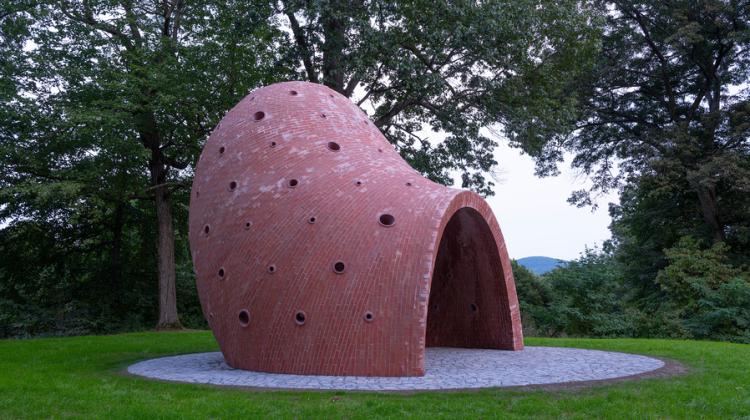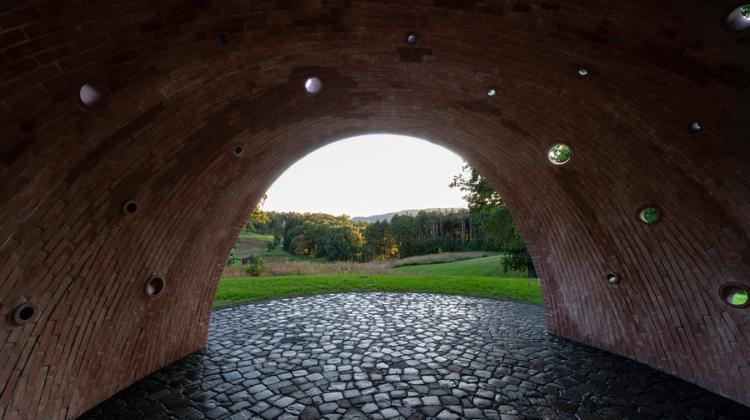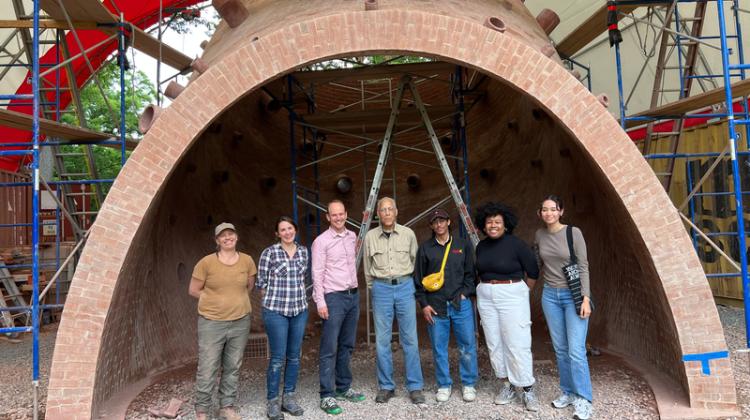In the Hudson River Valley, on a hill inside the Storm King Art Center, a new addition to the country’s leading outdoor sculpture collection was unveiled this fall. “Lookout,” by the eminent American sculptor Martin Puryear, is a beguiling, domed brick structure with confounding curves, a walk-in entrance, and 90 apertures.
The sculpture “could be the most amazing thing Martin’s ever done,” the noted curator John Elderfield told The New York Times.
“Lookout” also raises a question: How do you assemble an entirely curving building using rectilinear bricks, of all materials?
Answer: First, assemble a team of leading masonry experts to work on it — including several individuals who are MIT faculty, alumni, and students.
The vision of “Lookout” comes from Puryear, who is known for creating evocative shapes and deploying striking materials; it was partly inspired by ancient Nubian masonry techniques. But bricks are best suited for building rectangular structures. They work well in compression — stacking on to each other — but can pull apart when stretched into other shapes. Constructing the completely curvilinear “Lookout” in brick was a major challenge.
As it happens, several MIT-connected people played a key role assembling the sculpture, including John Ochsendorf, an MIT professor and expert in the design of unconventional structures; Lara Davis MArch ’10, a practicing architect and masonry specialist, and the project’s lead mason; Rebecca Buntrock MEng ’10, an engineer with the consulting firm Silman; and a group of students Ochsendorf assembled to analyze and help develop the structure. They joined with Puryear’s studio, collaborating closely with his lead studio assistant, Rob Horton, as well as other building specialists, in crafting “Lookout.
After more than a year of on-site construction, Puryear told MIT News, it “felt like a final miracle” to see the sculpture completed with the aid of the team — whose members in turn were delighted to help make “Lookout” a reality.
“Martin’s not just a great artist, he’s a great builder, he’s a great craftsman, he’s a maker in every sense of the word,” says Ochsendorf. “He also is devoted to materials and to truth and to an exploration of form. So, we explored this together.”
Adds Davis: “The genius of it is the combination of this really elegant apparent simplicity and technical sophistication.”
A common language around the brick
Puryear is one of the most accomplished sculptors in America. Having first gained notice in the 1970s, he now has a long list of major exhibits, installations, and awards to his name. In 2007, the Museum of Modern Art in New York featured a 30-year retrospective of his work; Puryear’s sculptures also represented the U.S. at the 2019 Venice Biennale for the Arts, and his work was featured multiple times in the Whitney Biennial. He has created many works standing as public installations. In 2011, Puryear was awarded the National Medal of Arts. He has also earned a MacArthur Fellowship and a Guggenheim Fellowship.
Puryear had already been envisioning “Lookout” for many years when a 2019 conversation with Ochsendorf, the MIT Class of 1942 Professor with appointments in the departments of Architecture and Civil and Environmental Engineering, helped hammer out a framework for building the massive sculpture.
“That meeting resulted in a collaborative structural solution that was almost instantaneous,” Puryear says.
As Puryear and Ochsendorf determined, “Lookout” would have two brick layers that would be largely self-supporting during construction. The masonry would reflect the Nubian practice of placing bricks at angles with rapidly drying mortar to create a unique curving shape. They also decided to place a steel grid in between those layers for establishing the complex geometry and for long-term reinforcement. Still, the crucial factor would be an extremely precise bricklaying process.
Certainly, Puryear was talking to the right person in Ochsendorf, an engineer and designer with a distinctive niche studying indigenous, ancient, and unusual architectural practices. Ochsendorf’s 2010 book “Guastavino Vaulting: The Art of Structural Tile,” examines the distinctive 19th-century masonry featured in New York’s Grand Central Terminal, Ellis Island, the National Museum of Natural History, and other prominent buildings. And Ochsendorf helped provide engineering analysis for the Sean Collier Memorial, designed by J. Meejin Yoon, on the MIT campus.
“I’ve long been interested in Nubian vault construction,” Ochsendorf says. “But it’s not every artist who knows about it. So, there was a common language around the brick and what it can do in three dimensions, and how we can get there.”
Ochsendorf adds: “When Martin feels something can be done, it probably can be done. The joy for me as someone who has studied masonry structures throughout cultures, time, and space, was that when I saw the form, I thought, yes, this can be done, but it’s not going to be easy, and we’re going to need a lot of talent to make this happen. That led to pulling together a team of MIT students and alums.”
Matching the mortar
For starters, Ochsendorf introduced Puryear to Davis, who became the lead mason on the project and produced dozens of detailed drawings of the structure. Davis had been a mason before earning her masters at MIT, where she studied with Ochsendorf. She then worked in India for a decade before returning to the U.S. and settling near Storm King.
“Lara was living, almost miraculously, only 30 minutes from my studio when we met, and she immediately brought her architectural background, her engineering training, and her hands-on bricklaying expertise to the project,” Puryear explains.
Indeed, a crucial part of the construction involved finding the right match of brick and mortar. Nothing with the shape of “Lookout” could use off-the-shelf materials. Instead, Davis carefully formulated a blend of natural cements to properly bind the bricks, testing out each option through a half-scale mockup built with Puryear’s studio.
“The material properties of the mortar and the brick together really had to be perfectly tuned in order for it be stable and cohesive as we were building it,” Davis says. “As we were building it up, there were points where I felt, wow, the shape is so unusual for masonry.”
Davis, in turn, also worked with masons Scott Cafarella and Mario Magana, of Hudson Valley Mason Works, to lay the bricks. The firm KC Fabrications, founded by Christopher Powers and Kurt Wulfmeyer, built the steel framework. Another of Puryear’s studio assistants, Aaron Getman-Pickering, also collaborated on the project.
Well before construction started, the team also performed multiple engineering assessments to see whether “Lookout” was viable — or if it would create too much structural tension for masonry. One of these studies was performed by Buntrock, a senior associate at Silman whose MIT master’s degree was in high-performance structures.
Additional analysis and planning was led by Ochsendorf, and helped by a team of six students: Sabrina Madera ’21, Jaime Osuna ’21, and MArch candidates Katie Rotman, Justin Brazier, Tejumola Bayowa, and Charlie Janson. Together they conducted further modeling and digital planning of the construction, down to the number of bricks the sculpture would need.
This kind of “early digital modeling” helped provide “a better view of what it might actually look like,” says Madera. “The gratification of seeing it built was just so wonderful.”
As the process of testing mock-ups indicates, the construction process itself was a highly collaborative one between the assembled team and Puryear’s studio, as the group worked to refine its practices and find solutions for any issue that came up. After many months of work taking place on scaffolding, the careful lifting of heavy component pieces into place, and precise measurements of the structure in progress, “Lookout” was completed by the gifted crew of masons and builders.
“It’s almost like a piece that we have spent our whole careers training for,” Davis says.
As “Lookout” reinforces, great sculpture starts with a vision, and gets completed after careful, exacting, hands-on craft work.
“It was a great intellectual challenge for us, but we were also relying on historical precedent,” Ochsendorf says. “Like Martin, we knew it was possible.”





